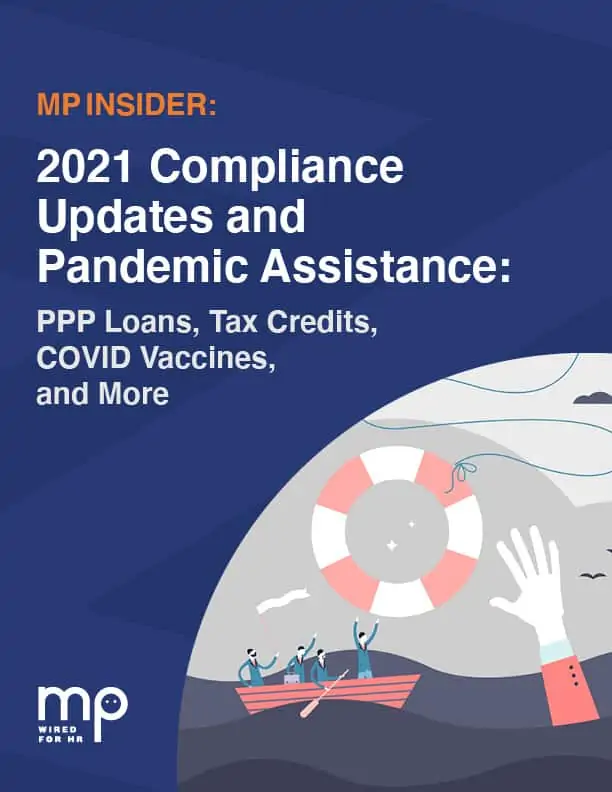Posted on January 25th, 2021
2021 Compliance Updates and Pandemic Assistance: PPP Loans, Tax Credits, COVID Vaccines, and More

MP INSIDER:
2021 Compliance Updates and Pandemic Assistance: PPP Loans, Tax Credits, COVID Vaccines, and More

Introduction
Find out everything your business needs to know to stay in compliance, as well as opportunities to get the loans and cashflow you might need to keep your business afloat through the pandemic and beyond. This eBook is organized in two parts. The first covers how to stay in compliance. It discusses the COVID vaccine, new rules on independent contractors and new workplace regulations for the pandemic. Part two is about pandemic assistance programs, including: updates on PPP loans and the Employee Retention Tax Credit, as well as some other smaller programs that offer ways to infuse your business with additional cashflow.
Table of Contents
- Part 1: Compliance Updates
- The COVID Vaccine
- New Rules About Independent Contractors
- New Pandemic-Related Compliance Requirements
- Part 2: Pandemic Assistance Programs
- PPP Loans
- The Employee Retention Tax Credit (ERTC)
- Additional Programs
The key to implementing an effective COVID-19 vaccine policy and addressing related accommodation requests is to look at each situation based on its own merits. Always engage in the interactive process to find the best solution for both the employee and employer.
Sheri Heller, SHRM-CP, PHR
Part 1: Compliance Updates

4 Essential Tips for Staying in Compliance with COVID Vaccine Policies
Ready or not, workplaces will need to decide what to do about the COVID vaccine. Here’s how to stay in compliance, whether you require the vaccine or you don’t.

Note
If you need a mandatory vaccination policy in your workplace, the best practice would be to ensure that it’s not overly rigid.
- The EEOC has stated that in some cases, employers may be able to create employee policies requiring COVID vaccination. Guidance says that simply administering the vaccine will not violate the ADA.
- It’s important that employers proceed with caution. Right now, it’s more likely that medical settings are the only workplaces that could easily make a good case for legally requiring employees to get the COVID vaccine. They are likely to be able to make a logical case that COVID and unvaccinated employees pose a threat to the business, clients, patients, etc.
- Employees may ask for an exception or accommodation from COVID vaccine policies for a few reasons: they have an allergy or medical condition, they have a disability (covered under the ADA) that prevents them from getting vaccinated, or getting vaccinated will violate the tenets of their religious practice.
- If you need a mandatory vaccination policy in your workplace, the best practice would be to ensure that it’s not overly rigid. Leave wiggle room for exceptions. It would also help to create your policy based on mandatory flu vaccination policies. Lastly, it’s recommended that you work with HR consulting experts like MP’s. This is such a delicate matter that you’ll want expert advice to avoid legal and liability exposure.
New Rules About Independent Contractors

The DOL has passed a rule on identifying independent contractors. This is the Independent Contractor Final Rule, which will take effect on March 7th. The rule shifts the
focus on who is an employee and who is an independent
contractor. Now, the two most paramount criteria come from the Economic Reality Test. The 2 core factors are:
• The degree of the worker’s control over their work, i.e., when to report to work, how they complete job duties, etc.
• The worker’s ability to realize a profit or loss. If a worker can realize a loss or profit independently of the employer, they
are an independent contractor.

The Independent Contractor Final Rule renders factors that used to matter less important in determining if a worker is an employee or independent contractor. These include a worker’s skill, the permanence of the relationship between the worker and employer, and how integrated they are with the employer’s staff or department. Most notably, benefits have been clarified as bad criteria for determining if a worker is an independent contractor. Providing perks, benefits, or reimbursements no longer automatically renders a worker an employee. However, if they do get access to the same benefit plan as other full- time employees, then they themselves are also most likely employees (not contractors).
Please note that state laws regarding employee/independent contractor classification can vary greatly. In most cases, the law that is most beneficial to the worker takes precedence. If employers have workers in states with stricter independent contractor tests, they will want to continue observing those guidelines.
New Pandemic-Related Compliance Requirements

Note
Employees can’t take more FFCRA leave if they’ve exhausted it. However, an employer has the option to grant workers FFCRA leave until the end of March if they haven’t taken it yet and do qualify for it.
- Electronic notices and postings: Because so many workplaces have gone remote, either temporarily or permanently, the DOL has allowed workplaces to share required notices and postings electronically with workers. This means they can be shared via email and intranet. They need to be easily referred to, not just shared and then gone.
- Telemedicine and the FMLA: Telemedicine visits may now count for FMLA requirements if they meet certain guidelines. These visits cannot just be a call to a doctor’s office. They must be a true interaction between doctor and patient.
- FFCRA leaves have been extended: There is now an optional extension of FFCRA leave into 2021. Note that employees can’t take more leave if they’ve exhausted it. However, an employer has the option to grant them FFCRA leave until the end of March if they haven’t taken it yet and do indeed qualify for it. Employers are not required to grant FFCRA leave now, though. They should, of course, deny or approve FFCRA leave in a uniform way across their staff to avoid accusations of discrimination.
Part 2: Pandemic Assistance Programs

The second round of PPP funds has a broader definition of expenditures. You are now able to use some of the funds for new insurance types, PPE, Payroll and HR services, and more.
Amanda Bridge, SHRM-CP
PPP Loans
PPP loans can be a significant infusion of cash for an organization, especially because obtaining full or partial forgiveness is becoming easier and easier. With some strategic planning and perhaps HR consulting or payroll services, companies could receive full forgiveness of their PPP loans. This eBook will cover the First and Second Draw programs, especially eligibility requirements and how funds can be spent.

Eligibility: For the new round of PPP loans, applicants must have fewer than 300 employees and be able to show a 25% or greater gross receipts reduction in comparable quarters between 2019 and 2020. Some new entities may apply:
- Nonprofits that fall under 501(c)6, including chambers of commerce.
- Local media outlets, which originally couldn’t have applied because of their affiliation with larger networks.

IRS expense deductibility: The IRS originally stated that business expenses paid for with PPP loans could not also be deducted on taxes. Now, this has changed. Employers can deduct business expenses on their taxes, even if they’re paid for by PPP loans.

Emergency Injury Disaster Loan (EIDL) Grants: These are ready for disbursement again and, in many cases, will be provided in up to $10,000 grants. Originally, when people got EIDL grants and PPP loans, the amount of their EIDL grant reduced the amount of forgivable monies on their PPP loans. This bill strikes that, meaning EIDL grants no longer affect how much can be forgiven on a PPP loan now. The bill will also create avenues for the businesses to recoup on forgivable monies if they already applied for forgiveness and lost out on money due to their EIDL grants.
Additional Covered Expenses: PPP loans can now be used for more expenses outside payroll than previously allowed. (Note that the 60-40% split is still necessary. 60% of a PPP loan must be used for payroll costs.) The list of acceptable expenses for the other 40% now includes:
- More insurance types, including life, disability, dental and vision.
- Covered supplier costs for goods that are essential to a business.
- Worker protection costs, including PPE, barriers, air filtration, health screenings, etc.
- Property damages from public unrest that are not covered by insurance can be paid for with PPP funds.
- Covered operations expenditures, including software and cloud computing can also be paid for with PPP funds. This includes Payroll and HR solutions, HCM solutions, and HR consulting (all of which MP provides), accounting, and sales and billing costs.
The covered period flexibility has increased from 8 to 24 weeks. People can now use 8 weeks, 24 weeks, or any increment of time between them.
The application deadline for this round of PPP loans will be March 31, 2021 or when the $284 billion that was set aside for the program has been exhausted. Available lenders may be different, and borrowers are not required to use the same lender if they already got a PPP loan previously. Lenders must apply and be approved to participate, and some banks may choose not to participate this time around. It’s worth noting that safe harbors for lenders have been added. This language protects lenders from litigation if the borrower is fraudulent.
Maximum loan amounts: on this round of PPP funding, employers may receive the lesser of $2 million or 2.5x their average monthly payroll (either from the calendar year 2019 or the 12 months prior to the loan, whatever is more advantageous). If the borrower is in the Food and Accommodation Services industry (this means they need to have NAICS code 72), they can get 3.5x their monthly payroll.
Forgiveness: There is a simplified forgiveness process and form (just one page) for PPP loans under $150,000. The form hasn’t been released yet as of this writing, but likely will be soon. It will only require borrowers to attest to:
- The number of employees retained
- The estimated loan amount used for payroll
- The loan total
Unfortunately, if somebody has already applied for forgiveness, most of the above items will not be applicable to them. These items will just apply to employers who haven’t applied for forgiveness yet.
The First Draw Program

The application window on this program opened on January 11th, 2021. The average loan given out will be 2.5 times the average monthly payroll of the borrower, maxing out at up to $10 million (with the maximum per employee being $100 thousand). To calculate payroll costs, employers can use figures from 2019, 2020, or the previous 12 months from when they apply.
On this new round of PPP loans, funds can be used on an expanded list of allowable expenses, including cloud computing software and employee protections like PPE and plexiglass barriers. (It’s still unclear as to whether employers with previous PPP loans can use their funds on this expanded list of allowable expenses. Guidance to come.)
The eligibility requirements are also different on this round of loans. Employers must:
- Have 500 or fewer employees (Accommodations and Food Service companies can have fewer than 500 at each location)
- Not have participated in the first PPP program or didn’t accept the full amount they were eligible for.
The Second Draw PPP Loan Program
This program is for applicants who don’t fit into the First Draw PPP Loan Program. The maximum amount for the loan is 2.5 times monthly payroll costs or 3.5 times monthly payroll costs for industries like Accommodations and Food Services. Loans will be no higher than $2 million total.
The application window opened on January 13th, 2021. To qualify, employers must:
- Have fewer than 300 employees (for some industries like Food Services and Accommodations, it can be counted as less than 300 employees per location).
- Have used all the monies in their first PPP loan. Note that this doesn’t mean they need to have filed a forgiveness application.
- Be able to show a 25% or greater decline in gross receipts from 2019-2020 (this can be either by year or by quarter, whatever is most advantageous).
The Employee Retention Tax Credit (ERTC)
The Employee Retention Tax Credit (ERTC) is now more widely available to employers than it was last year. Many employers who didn’t qualify in 2020 (because they took a PPP loan) will now qualify for 2021 and 2020 retroactively. Organizations who keep up with details of this program could be walking away with thousands towards their taxes, or potentially even a substantial refund.
Eligibility
Many didn’t take advantage of this program initially because they thought they could only choose to use their PPP or this program. The new bill allows them to use both. (Note that there is a caveat, which is that employers cannot apply the credit to wages that they used forgiven PPP funds on. One way to deal with this is to be very strategic about what the chosen covered period is.) There is now also ERTC available for the first two quarters of this year. To be eligible, employers must have fewer than 500 employees and be able to prove that year-over-year gross receipts have declined by 20% (rather than 50%, as it was previously).

Note
There is a caveat, which is that employers cannot apply the credit to wages that they used forgiven PPP funds on. One way to deal with this is to be very strategic about what the chosen covered period is.
To be eligible for retroactive 2020 ERTC employers need to be able to prove that their gross receipts have declined by 50%.
They could also choose to prove that for the quarter that the credit is claimed for, the employer had to have a full or partial shutdown due to a governmental order. The definition of this is fairly broad, as most governmental orders that cause more than a nominal disruption in operations will qualify.
Be able to show a gross receipts decline of 50% in 2020 in any given quarter.
If there’s a quarter during which the organization returns to 80%, they stop being eligible at that point. For eligibility to claim an ERTC in 2021, an organization only needs to be able to show 20% gross receipts decline.
Gross receipts are all the revenue in any forms it was accrued or received from any sources.
This includes the sales of products or services, interest, dividends, rents, royalties, fees, commissions, etc. as they were reduced by rents or allowances. Gross receipts are the “total income” or (“gross income” in the case of a sole proprietorship) plus the “cost of goods sold.” Internal Revenue Service (IRS) tax return forms such as Form 1120, Form 1120S, Form 1065, and Form 140 all define gross receipts. Note that gross receipts do not include net capital gains or losses, taxes collected for and remitting to a taxing authority if included in gross or total income, such as sales or other taxes collected from customers and excluding taxes levied on the concern of its employers. PPP funds should not be counted towards gross receipts, either.
Employers may use the preceding quarter if it’s advantageous. If they want to claim the ERTC in the first quarter of 2021, for example, they can show a loss in the fourth quarter of 2020.
What You Can Claim
It used to be the case that the amount of the credit an employer could claim was up to 50% of each eligible employee’s wages, for up to $10,000 in wages. The total maximum credit for 2020 is $5,000 per employee. Now, an employer can claim up to 70% of each eligible employees’ wages, up to $10,000 per quarter. This maxes out at $7,000 per employee in both the first and second quarters of 2021 for a total possible 2021 ERTC of $14,000 per employee.
To determine company size, employers should look at their records from 2019. Organizations with 100 full-time employees (workers who put in 30 or more hours a week of service) are considered “large employers.” For 2021, employers with 500 employees or more counts as a “large employer.” Small employers can claim credit on any wages paid. Large employers can only claim credit on employees who are paid. Note that “paid” is an important designation. Workers who were furloughed, but still had their group health insurance, count as “paid.”
For 2020, employers can claim 50% of a full-time employee’s wages, up to a cap of $5,000 per head, for the whole year. For 2021, employers can claim 70% of a full-time employee’s wages, up to a cap of $7,000 per head, for both the first and second quarter. That’s $14,000 per full-time employee total for the year.
Additional Programs Employers Should Know About
Here are some additional grants and loan programs that employers may be able to access for additional pandemic support.
- The SBA7(a): This is a type of loan. It can be used towards working capital, inventory, equipment costs, and business acquisitions. It’s available in amounts of up to $5 million in loans if you have 500 employees or $7.5 million or less in annual receipts. Borrowers do not need to be able to show losses to qualify. Some loan relief will be offered of up to $9,000 per month in repayment assistance for 6 months of new loans. Up to 8 months of assistance will be offered in select industries.
- Emergency Injury Disaster Loan (EIDL) Grants: These are ready for disbursement again and, in many cases, will be provided in up to $10,000 grants.
- Save Our Stages Grants: These are grants of up to $10 million for theatres, etc. If you receive one, you cannot also get a PPP loan.
- State-level grants: These may become available in addition to PPP loans, EIDL grants, etc.
- Miscellaneous tax breaks: Employee social security tax deferral repayment has been extended to 12/31/2021. Business meals are now 100% deductible on taxes.
- FSA relief: There will be a rollover of 2020-2021 and 2021-2022, which will allow a grace period extension for an entire 12 months.
- Employers may allow ‘spend down’ for terminated employees. This only used to be allowed for dependent care.
- Dependent care eligibility can now be covered up to age 14.
- Mid-year changes are now allowed.
Wire Your Business for Success
MP has been a leading provider of HR and payroll solutions for companies across the US for nearly two decades. We offer a comprehensive suite of products and services delivered in one unified, easy-to-use platform. We support clients as they cultivate excellent corporate culture, improve employee engagement, and strive towards their business goals. Since 2014, MP has been on the Inc. 5000 list and has won the Boston Business Journal Fastest Growing Companies Award.


